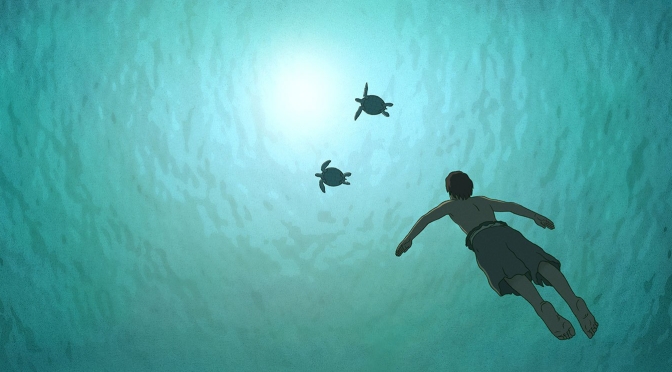★★★★
Studio Ghibli, that powerhouse of Japanese animation, stirred panic among certain cineastes back in 2014 when they announced that When Marnie Was Here would mark a temporary hiatus in production to coincide with the retirement of co-founder Hayao Miyazaki. Three years on, Miyazaki has thankfully resumed his position to direct one more feature – hoorah! In the meantime, to whet our appetites, Michaël Dudok de Wit’s The Red Turtle marks a excitingly potent co-production between Ghibli and European distributor Wild Bunch.
With beautiful hand-drawn aesthetics, lying somewhere between Hergé and Manga, The Red Turtle is the story of a man who is finds himself shipwrecked by a storm upon a island, deserted but for animals and vegetation. Resourceful and attempting to escape his paradisal prison, the man – who is never named – builds a bamboo raft and sets sail into the now calm ocean. This is, however, to be to be the first of three rafts the man will build. Each time he sets sail, the raft only ever makes it so far out before mysteriously collapsing; it is only on his third attempt that the man discovers that thwarting him is a large, red turtle.
Clear from the film’s title alone is the key significance of colour here. In his charcoal masterpiece Father and Daughter, the short that allegedly persuaded Ghibli to initiate the project, De Wit demonstrated both his comfort in monochrome and eye for the ability of colour to present stark and stunning contrasts. In that respect, The Red Turtle may even be considered something of a spiritual sequel to Father and Daughter. Throughout the breezy runtime, saturation washes back and forth – like the very ocean waves depicted – over the animation. The film opens with a storm which is depicted in almost total greywash and it is only as the man begins to explore the island that its voluptuous colourings bloom in a revelatory fashion. As a palette paired down to basics, De Wit’s style is supreme.
Similarly scaled back is the film’s script. Dialogue has no presence here, leaving a universality in the story being told through score and the occasional cry of ‘Hey!’ Even with the later arrival an Eve accompanying figure for the man’s Adam, the characters communicate only through gesture. Playing with illusion, and mimicking the motion of swimming, fantastical moments of flight liken the work to Dianne Jackson’s The Snowman, whilst the second half compares to last year’s Ethel and Ernest – both based on a Raymond Briggs story. There is much of Briggs’ humanism, magic and poignancy at the heart of The Red Turtle but here are an Ethel and Ernest who miss the entirety of civilisation in their own isolation. That said, it would be wrong to call De Wit’s work simplistic. So profound is the film that themes of reincarnation and resurrection are drawn deftly alongside repetitive metaphysical religious metaphor.
Rather like Disney’s own experiment in orchestrally orated storytelling: Fantasia, The Red Turtle is painted with strokes both light and dark. The latter of these may present images and tones too tough for younger viewers. De Wit’s Christ-like protagonist experiences the initiation and conclusion of life on the island whilst is himself tested in ways that he doesn’t always get right. Also like Walt’s 1940 film, this is an experiment with admirable ambitions slightly broader than its achievements. Watching requires a degree of unquestioning acceptance of the paths taken in plot which mightn’t work for all viewers.
Wearing its heart, soul and design entirely on its sleeve, The Red Turtle is arthouse animation at its most accessible. As a sight to see it is lovely; as an experience to view it is an intimate piece of escapism that leads you on a thoroughly rewarding journey.
T.S.



The magic of The Red Turtle ultimately comes down to the miracle of organic matter’s transformative recycling. Life always finds a way, and death is always a part of that.
LikeLiked by 1 person
Very nicely put
LikeLike